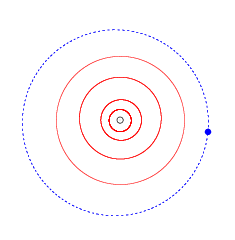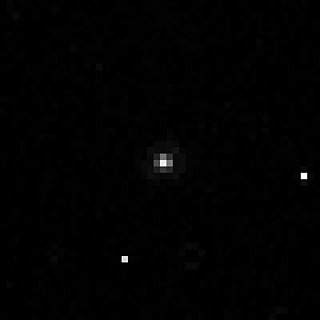
A classical Kuiper belt object, also called a cubewano ( "QB1-o"), is a low-eccentricity Kuiper belt object (KBO) that orbits beyond Neptune and is not controlled by an orbital resonance with Neptune. Cubewanos have orbits with semi-major axes in the 40–50 AU range and, unlike Pluto, do not cross Neptune's orbit. That is, they have low-eccentricity and sometimes low-inclination orbits like the classical planets.

1998 WW31, is a non-resonant trans-Neptunian object and binary system from the Kuiper belt located in the outermost region of the Solar System, approximately 148 kilometers (92 miles) in diameter. It was first observed on 18 November 1998, by American astronomer Marc Buie and Robert Millis at the Kitt Peak National Observatory in Arizona, United States. In December 2000, a minor-planet moon, designated S/2000 (1998 WW31) 1 with a diameter of 123 kilometers (76 miles), was discovered in its orbit. After Charon in 1978, it was the first of nearly 100 satellites since discovered in the outer Solar System.

53311 Deucalion, provisional designation 1999 HU11, is a trans-Neptunian object from the classical Kuiper belt, with a diameter of approximately 130–210 kilometers (81–130 miles), located in the outermost region of the Solar System. The cubewano belongs to the cold population and was discovered on 18 April 1999, by the Deep Ecliptic Survey at the Kitt Peak National Observatory in Arizona, United States. It was named after Deucalion, from Greek mythology.

(48639) 1995 TL8 is a binary trans-Neptunian object from the scattered disc in the outermost regions of the Solar System. It was discovered by Arianna Gleason in 1995 and measures approximately 176 kilometers in diameter. Its 80-kilometer minor-planet moon, provisionally designated S/2002 (48639) 1, was discovered on 9 November 2002.
(24835) 1995 SM55, provisional designation 1995 SM55, is a trans-Neptunian object and member of the Haumea family that resides in the Kuiper belt, located in the outermost region of the Solar System. It was discovered on 19 September 1995, by American astronomer Nichole Danzl of the Spacewatch program at Kitt Peak National Observatory near Tucson, Arizona, in the United States. It measures approximately 200 kilometers in diameter and was the second-brightest known object in the Kuiper belt, after Pluto, until 1996 TO66 was discovered.
(79983) 1999 DF9 is a trans-Neptunian object of the Kuiper belt, classified as a non-resonant cubewano, that measures approximately 270 kilometers in diameter.
(35671) 1998 SN165, prov. designation: 1998 SN165, is a trans-Neptunian object from the Kuiper belt located in the outermost region of the Solar System. It was discovered on 23 September 1998, by American astronomer Arianna Gleason at the Kitt Peak National Observatory near Tucson, Arizona. The cold classical Kuiper belt object is a dwarf planet candidate, as it measures approximately 400 kilometers (250 miles) in diameter. It has a grey-blue color (BB) and a rotation period of 8.8 hours. As of 2021, it has not been named.

(40314) 1999 KR16 is a trans-Neptunian object on an eccentric orbit in the outermost region of the Solar System, approximately 254 kilometers (158 miles) in diameter. It was discovered on 16 May 1999, by French astronomer Audrey Delsanti and Oliver Hainaut at ESO's La Silla Observatory in northern Chile. The very reddish object is a dwarf planet candidate and has a rotation period of 11.7 hours.
(44594) 1999 OX3 is an eccentric trans-Neptunian object with a centaur-like orbit from the outer Solar System, approximately 150 kilometers in diameter. It was discovered on 21 July 1999, by astronomers John Kavelaars, Brett Gladman, Matthew Holman and Jean-Marc Petit at Mauna Kea Observatories, Hawaii, United States.
(444030) 2004 NT33 is a classical trans-Neptunian object and possible dwarf planet of the Kuiper belt in the outermost region of the Solar System, approximately 450 kilometers in diameter. It was discovered on 13 July 2004, by astronomers at Palomar Observatory, California, United States.
(144897) 2004 UX10 is a Kuiper-belt object. It has a diameter of about 360 kilometres (220 mi) and was discovered by Andrew Becker, Andrew Puckett and Jeremy Kubica on 20 October 2004 at Apache Point Observatory in Sunspot, New Mexico. The object is classified as a cubewano. It is near a 2:3 resonance with Neptune.
(589683) 2010 RF43, provisionally designated: 2010 RF43, is a large trans-Neptunian object orbiting in the scattered disc in the outermost regions of the Solar System. The object was discovered on 9 September 2010, by American astronomers David Rabinowitz, Megan Schwamb and Suzanne Tourtellotte at ESO's La Silla Observatory in northern Chile.
(523645) 2010 VK201, provisional designation 2010 VK201, is a trans-Neptunian object and member of the classical Kuiper belt, approximately 500 kilometers (310 miles) in diameter. It was discovered on 1 November 2010, by the Pan-STARRS 1 survey at Haleakala Observatory, Hawaii, United States. It has a rotation period of 7.6 hours. It was numbered in September 2018 and remains unnamed.

(416400) 2003 UZ117 is a trans-Neptunian object and suspected member of the Haumea family, located in the Kuiper belt in the outermost region of the Solar System. It was discovered on 24 October 2003, by astronomers of the Spacewatch survey project at Kitt Peak Observatory, Arizona. The object may also be a non-resonant cubewano.
(523674) 2013 MA12, provisional designation 2013 MA12, is a classical trans-Neptunian object and dwarf planet candidate from the Kuiper belt, located in the outermost region of the Solar System, approximately 340 kilometers (210 miles) in diameter. The cubewano belongs to the hot population. It was discovered on 26 July 2011, by astronomers with the Pan-STARRS survey at Haleakala Observatory, Hawaii, United States.
(505448) 2013 SA100, provisional designation 2013 SA100 and also known as o3l79, is a trans-Neptunian object from the classical Kuiper belt in the outermost region of the Solar System. It was discovered on 5 August 2013, by astronomer with the Outer Solar System Origins Survey at the Mauna Kea Observatories, Hawaii, in the United States. The classical Kuiper belt object belongs to the hot population and is a weak dwarf planet candidate, approximately 260 kilometers (160 miles) in diameter.
(523702) 2014 HW199, provisional designation 2014 HW199, is a trans-Neptunian object from the classical Kuiper belt, located in the outermost region of the Solar System. It was discovered on 30 January 2011, by astronomers with the Pan-STARRS survey at Haleakala Observatory, Hawaii, United States. The classical Kuiper belt object is also a dwarf planet candidate, as it measures approximately 290 kilometers (180 miles) in diameter.
(523684) 2014 CQ23, provisional designation 2014 CQ23, is a trans-Neptunian object and cubewano from the Kuiper belt, located in the outermost region of the Solar System. It was discovered on 13 March 2011, by astronomers with the Pan-STARRS survey at Haleakala Observatory, Hawaii, United States. The classical Kuiper belt object belongs to the hot population and is a dwarf planet candidate, as it measures approximately 330 kilometers (210 miles) in diameter.
(523687) 2014 DF143, provisional designation 2014 DF143, is a trans-Neptunian object and cubewano from the Kuiper belt, located in the outermost region of the Solar System. It was discovered on 12 April 2011, by astronomers with the Pan-STARRS survey at Haleakala Observatory, Hawaii, United States. The classical Kuiper belt object belongs to the hot population and is a dwarf planet candidate, as it measures approximately 350 kilometers (220 miles) in diameter.
(505624) 2014 GU53, provisional designation 2014 GU53, is a trans-Neptunian object and cubewano from the Kuiper belt, located in the outermost region of the Solar System. It was discovered on 8 April 2014, by astronomers with the Pan-STARRS survey at Haleakala Observatory, Hawaii, United States. The classical Kuiper belt object belongs to the hot population and is a dwarf planet candidate, as it measures approximately 330 kilometers (210 miles) in diameter.







